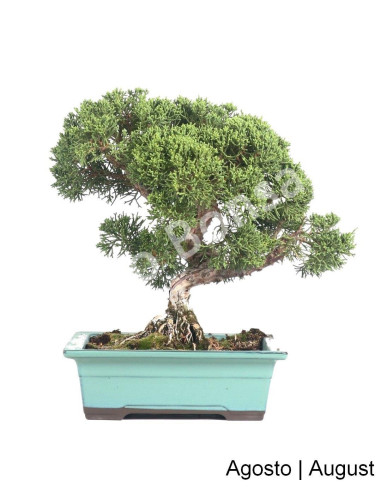- -10%
Juniperus Itoigawa Bonsai 23 years
Species from China and Japan, belonging to the Cupressacea family.
Although practically all species can be transformed into Bonsai, most cannot "compact" after formation pruning, the Juniperus Itoigawa, in addition to compacting very well, is greatly appreciated by the light green of the needles, and by the hardness of its ideal wood for dead wood (Jin and Shari).
Juniperus Itoigawa Bonsai is an outdoor plant.
Common Name: Juniperus
Scientific name: Juniperus Chinensis
Characterization: From China and Japan, it belongs to the Cupressace family.
Although practically all species can be transformed into Bonsai, most cannot "compress" after formation pruning.
The best for Bonsai are Japanese varieties, "Juniperus Sargentii" much appreciated by its lush green, and the "Juniperus "Itoigawa" for the hardness of its wood to make dead wood (Jin and Shari).
Much appreciated is also the Juniperus Sabina, which is quite usual in the Iberian Peninsula.
The Juniperus Rigida, with similar maintenance care, is also greatly admired by the fact that its leaves are needles rather than "scamas", and by this characteristic they compact easily responding well to severe prunings. He's got a "sweep" counterpart when we work it out.
Location: Outside, where take 3 to 4 hours of direct sun per day (ideal in the morning or late afternoon), protected from strong winds and frosts. It is very resistant to both cold and heat.
Watering: To water abundantly the earth until a lot of water goes out through the drain holes in order to moisten evenly the soil, always above never by immersion, with a fine drain waterer.
Tips on watering, see technical data watering.
Let slightly dry the surface layer of the soil between each watering (to confirm if the plant already needs water, touch the earth with the fingers).
If you have a dish under Bonsai, never leave any water in it (to prevent the roots from rotting).
It has high water consumption, mainly in summer and likes to be sprayed on leaves at the act of watering, which will prevent the appearance of red scratch, but should be dry at night to avoid fungi
Nutrition: From February to October/November, with a base plan composed of a complete fertilizer (Fertil Bonsai Humic, or Green & Gold Bonsai Organic or Biogold), and a biostimulant (Bio Bonsai Activ), can still be linked with other products in our range.
Detailed information on how to combine these products the rest of our range, or for a more specific nutrition plan, see complete nutrition plan technical sheet.
Poda: Its leaves are scales, and must be pruned for maintenance by pinching them with the fingers, if we use scissors the cutting zones become dry.
The formation pruning should be made using scissors and pliers always trying to cut in a way to replace with a new sparse sprout.
The maintenance pruning is made all year long, while the formation pruning is usually done in winter or post summer, so that there is still Outonal growth that compacts the plant.
Most varieties tend not to compact after formation prunings, this is due to the natural mechanism of defense of the plant that when very pruned for a while does not give scales and goes on to give needles (in nature this mechanism makes plants or zones of the plant very "pasted" to be temporarily protected because animals are chopped).
This process of defense, prevents the good aesthetic result of many varieties because we never get them with beautiful scales by the branches, only when we let them "look away" from the canopy, they stop giving needles, and they get scales again, but then the "draw" of Bonsai has already been lost.
Tips on pruning, see the technical sheet pruning and defoliation.
Transplant: With Terra Bonsai Coníferas in February/March, when the bud begins.
For specimens in small vessels or cultivated in very hot zones, a solution to maintain soil hydration given high water consumption in the summer months is to mix with 50% Terra Bonsai Coníferas, more 50% Terra Bonsai Folhosas or Akadama.
Details about transplants, post transplants and specific fortifiers that you can use refer to repotting technical sheet.
Scratch: Ideally from late winter to early spring, but it can be all year round. Normally we take advantage of together making a cleaning pruning.
Indications on padding, see scraping machine.
- Habitat
- Outdoor
- Sheet Type
- Persistent
- Species
- Juniperus Itoigawa
- Origin
- Japan




































